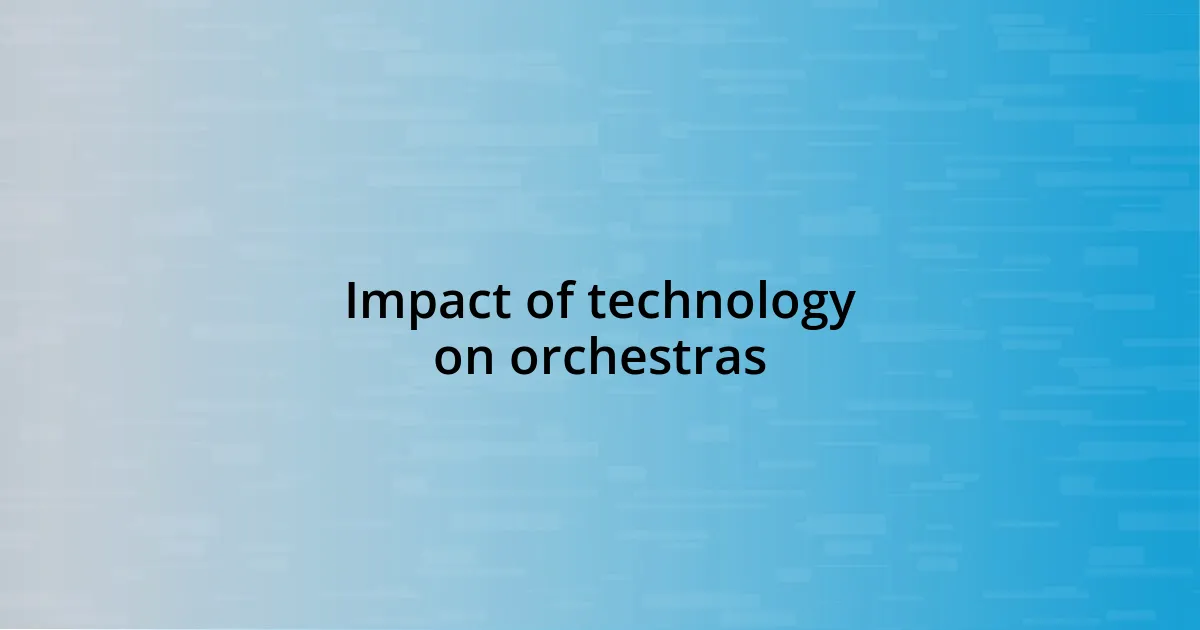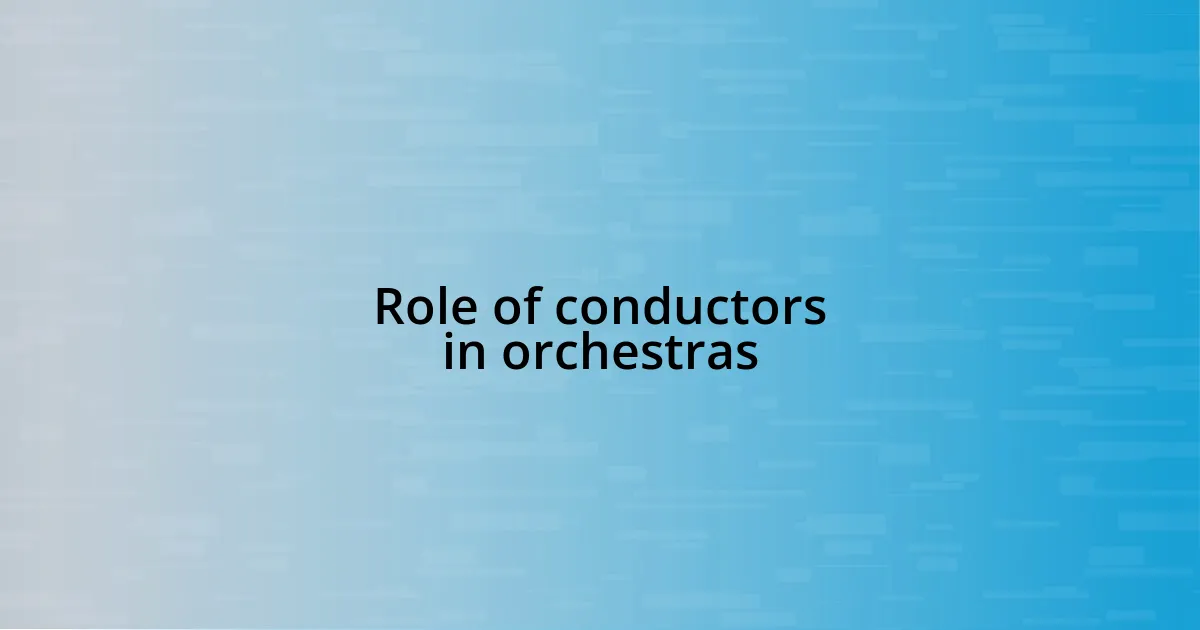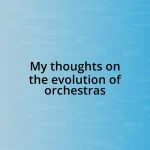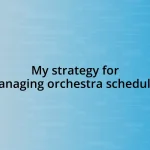Key takeaways:
- The evolution of orchestras from small ensembles in the 16th century to large, complex formations in the Romantic era highlighted cultural shifts and emotional intensity in music.
- The impact of technology has transformed orchestras, enabling digital distribution, enhanced sound quality, and innovative compositions, making orchestral music more accessible and engaging.
- Conductors play a crucial role in shaping performances and connecting musicians with audiences, enhancing the emotional depth of orchestral music.
- Orchestras are adapting to modern audiences by blending genres and utilizing technology, fostering community engagement and nurturing future musicians.

The history of orchestras
The history of orchestras is a fascinating journey that has evolved significantly since its inception in the late 16th century. At that time, orchestras were small groups of musicians, often led by a single conductor, who played music for various events. I remember attending my first symphony, completely mesmerized by the lush soundscape created by a blend of strings, woodwinds, and brass—all harmonizing in a way that felt almost magical.
As we moved into the Classical period, the orchestra grew in size and complexity, with composers like Haydn and Mozart adding depth to the sound through innovative arrangements. Isn’t it intriguing how music reflects the cultural shifts of its time? I often find myself thinking about how the advent of the Romantic era marked a pivotal shift, as orchestras expanded even further, embracing a wider array of instruments and fostering a new emotional intensity in music.
The 20th century introduced dramatic changes with the rise of new genres and the incorporation of technology, transforming the orchestral landscape. I vividly recall hearing Stravinsky’s “The Firebird” for the first time and being struck by its vibrant orchestration. It’s these moments that remind me of the orchestra’s ability to adapt, grow, and convey the human experience through sound, illustrating that the evolution of orchestras is not just a historical timeline but a rich tapestry of artistic expression.

Key changes in orchestral music
Key changes in orchestral music
The shift from chamber ensembles to larger orchestras marked a significant change in the musical landscape. I remember sitting in a concert hall where the sheer number of musicians on stage created a palpable energy. It was as if the collective sound could wrap around me, bringing every note to life in a way that smaller ensembles simply couldn’t replicate.
As the 20th century progressed, orchestras began to incorporate diverse musical elements, including genres like jazz and film scores. This fusion not only broke traditional boundaries but also resonated with audiences in new ways. I experienced this firsthand when I attended a concert featuring Copland’s “Appalachian Spring,” which blended classical elements with American folk music, leaving me with a sense of nostalgia and connection to my roots.
Another pivotal change has been the role of technology in orchestral performances. With advancements in sound production and amplification, the experience of live orchestral music has become richer than ever. I recall my initial reaction to hearing a symphony amplified through modern equipment; the clarity and depth were astonishing, allowing every instrument’s subtleties to shine through. This evolution truly demonstrates how orchestras continue to adapt while still cherishing their rich heritage.
| Time Period | Key Changes |
|---|---|
| 16th-18th Century | Small ensembles evolve into larger orchestras with increased complexity. |
| 19th Century | Orchestras expand to include more diverse instruments and emotional depth. |
| 20th Century | Introduction of new genres and technology reshaping the orchestral experience. |

Impact of technology on orchestras
The impact of technology on orchestras has been profound, reshaping how we experience this timeless art form. I still remember the first time I watched a live-streamed performance of a renowned orchestra. The crisp visuals and impeccable audio quality transported me right into the concert hall, as if I were sitting among the audience. It struck me how technology now grants access to orchestral music across the globe, breaking geographical barriers and expanding appreciation for this magnificent genre.
Here are some key ways technology is influencing orchestras:
- Digital Distribution: Online platforms allow orchestras to share performances, reaching audiences far beyond local venues.
- Enhanced Sound Quality: Advanced audio equipment captures every nuance of a performance, making the listening experience more immersive.
- Innovative Compositions: Composers are experimenting with electronic elements, blending traditional orchestral sounds with digital effects.
- Interactive Concerts: Some orchestras incorporate mobile apps to engage audiences, providing real-time information about pieces being performed.
- Education and Outreach: Virtual masterclasses and workshops can easily connect young musicians with seasoned professionals, fostering new talent.
Through these innovations, I can’t help but feel a sense of excitement for the future of orchestral music. I’ve witnessed how these changes can breathe new life into age-old conventions, making orchestras more relevant and accessible to today’s audiences. The fusion of tech and tradition inspires a new generation of composers and musicians, making me optimistic about where orchestras are headed next.

Evolution of orchestra composition
The evolution of orchestra composition is a fascinating journey, reflective of broader cultural shifts. I find it interesting how, in the late 18th century, composers began expanding their orchestras beyond strings and woodwinds to include brass and percussion. I recall diving into Beethoven’s music and realizing how he dramatically transformed the relationship between composer and performer, paving the way for a much richer, layered sound that captivated audiences like never before.
Fast forward to the 19th century, orchestras became fully symphonic, and this evolution sparked a richer emotional connection with the audience. When I listen to Tchaikovsky’s symphonies, I can’t help but feel drawn into his world, where every instrument tells a story. The incredible increase in timbres and dynamics allowed composers to convey deep, sometimes tumultuous emotions that resonate even today. Have you ever felt utterly transported by a single chord? That moment is what I believe orchestral evolution is about—the ability to evoke feelings that transcend language and culture.
As orchestras crossed into the 20th century, the style of composition began to embrace even more diversity. Experiencing contemporary works by composers like John Adams reminds me of the boundaries that have been stretched. When I attended a performance blending orchestral music with electronic soundscapes, it felt like the possibilities were endless. What if orchestras continue to evolve this way, integrating even more genres and technology? I can’t help but feel excited about this ongoing transition, as it reflects not just music’s evolution, but our shared journey as a society.

Role of conductors in orchestras
The role of conductors in orchestras is pivotal, serving as the bridge between the composer’s vision and the musicians’ execution. From my experiences attending various performances, I’ve seen firsthand how a conductor’s gestures can evoke a range of emotions. It’s fascinating how a simple wave of the baton can set the pace for an entire symphony, infusing each note with life. When a conductor leads with passion, you can feel the orchestra respond, creating an electric atmosphere that resonates with the audience.
Beyond just keeping time, conductors interpret the music in a way that shapes the performance’s character. I remember watching a conductor pause with a sweeping hand motion before a particularly intense passage, almost as if he was inviting the orchestra to breathe deeply before diving in. This visible interpretation adds layers of meaning that can transform a familiar piece into something extraordinary. I think about how, without that expressive leadership, orchestral performances might lack the depth that truly moves listeners.
Moreover, conductors often play the role of educators, guiding musicians through intricate scores and instilling a sense of cohesion within the group. During a rehearsal I attended, the conductor stopped to explain the emotional underpinning of a piece, which made me appreciate the nuances in the performance even more. It made me wonder, what would orchestras be without these maestros? Their expertise doesn’t just connect musicians; it connects us, the audience, to the rich tapestry of narrative behind each orchestrated piece.

Audience engagement and orchestras
One of the most striking aspects of audience engagement with orchestras is how the experience can ignite a profound sense of connection. I vividly remember one evening where the orchestra played a contemporary composition that was unlike anything I had ever heard. The way the music ebbed and flowed created an almost visceral reaction in me; I was not just a passive listener but a participant in a shared emotional journey. Can you recall a moment when a performance moved you so deeply that the boundaries between musician and audience seemed to blur?
Orchestras today are increasingly aware of the need to bridge the gap between the performers and the audience. I once attended a concert where the musicians interacted with the audience, inviting questions and even sharing personal stories about their relationship with the pieces. That openness made the experience feel intimate and vibrant—like I was truly part of the orchestra’s world. It’s refreshing to see orchestras embracing this kind of engagement, as it fosters a sense of community and connection that can make the music feel even more impactful.
Additionally, the rise of digital platforms has revolutionized how orchestras reach out to their audiences. I recall watching a rehearsal live-streamed on social media, and it was incredible to see the musicians in action, even from afar. This accessibility not only brings in new audiences who might not have experienced orchestral music otherwise, but it also creates a deeper bond with those who are already fans. Have you ever felt a rush of excitement seeing an orchestra share behind-the-scenes moments? It’s a beautiful testament to how music, when shared authentically, can resonate with people on a personal level, regardless of where they are.

Future of orchestras in society
As I reflect on the future of orchestras in society, I can’t help but think about how they are evolving to resonate with younger generations. Recently, I attended a concert where the program blended classical pieces with popular tunes. It was amazing to see how the audience, especially the younger ones, engaged with both genres seamlessly. This fusion shows just how adaptable orchestras can be, ensuring they remain relevant in an ever-changing musical landscape.
I’ve noticed that many orchestras are also embracing technology. For instance, I once participated in a workshop that combined orchestral music with virtual reality experiences. The ability to immerse oneself in an orchestral piece while virtually exploring the space where it was composed was exhilarating. It made me wonder, could this be a glimpse into the future of audience engagement? By leveraging technology, I believe orchestras have the power to create interactive experiences that draw in a diverse audience, making the music not just something you hear, but something you truly feel.
Moreover, orchestras are finding new ways to contribute to their communities. Recently, I attended a performance partnered with a local school, where young musicians showcased their talents alongside the orchestra. It was heartwarming to see the smiles on their faces as they played; you could feel the excitement in the air. I think this kind of outreach not only nurtures the next generation of musicians but also strengthens community ties. Isn’t it fascinating how music can bring people together like that? The future of orchestras is not just about performances; it’s about building relationships and fostering a love for music in people of all ages.














